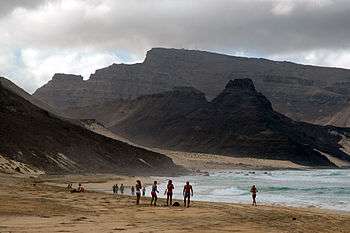Geology of Cape Verde

Cape Verde is a volcanic archipelago situated above an oceanic rise that puts the base of the islands 2 kilometers (1.2 mi) above the rest of the seafloor. Cape Verde has been identified as a hotspot and it has been argued that a mantle plume might be underneath it causing the volcanic activity and associated geothermal anomalies.
Though Cape Verde's islands are all volcanic in origin, they vary widely in terrain.[1] A still-active volcano on the island of Fogo is the highest point on the archipelago (elevation 2,829 meters or 9,281 feet).[1] Extensive salt flats are found on Sal and Maio.[1] On Santiago, Santo Antão, and São Nicolau, arid slopes give way in places to sugarcane fields or banana plantations spread along the base of towering mountains.[1]
The islands are geologically principally composed of igneous rocks, with basic volcanics and pyroclastics comprising the majority of the total volume. The volcanic and plutonic rocks are distinctly basic in character. The archipelago is an example of a soda-alkaline petrographic province, with a petrologic succession which is similar to that found in other Mid Atlantic islands. Mount Fogo is an active volcano which most recently erupted in 1995. Fogo’s caldera is 8 km (5 mi) in diameter, the rim is at an elevation of 1,600 m (5,249 ft) with an interior cone rising to 2,830 m (9,285 ft) from the crater's floor level. Calderas probably result from the subsidence, following the partial evacuation of the magma chamber, of a cylindrical block into the supplying magma chamber, in this case lying at a depth of some 8 km (5 mi). The archipelago has been dated at approximately 180 million years old.[2]
References
- 1 2 3 4 The Peace Corps Welcomes You to Cape Verde. Peace Corps (April 2006). This article incorporates text from this source, which is in the public domain.
- ↑ Mitchell-Thomé, Raoul C. "Outline of the geology of the Cape Verde Archipelago" Geologische Rundschau, Volume 61, Issue 3, pp.1087–1109